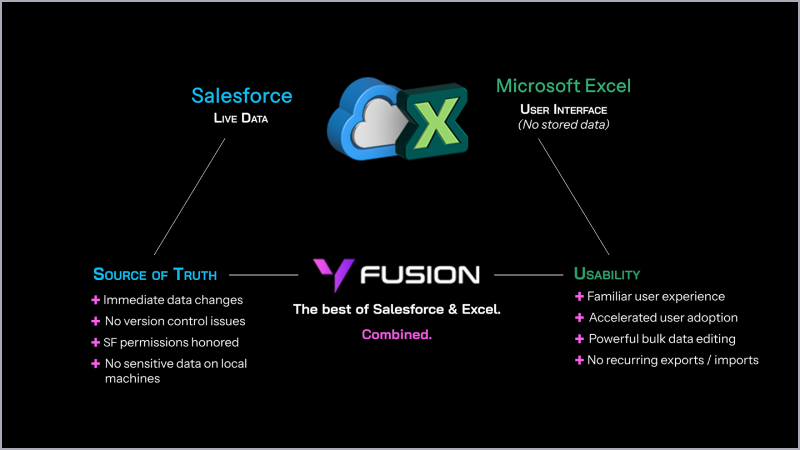5 Excel to Salesforce Integration Tools in 2024 to Boost Productivity, Simplify Data Management

With over 20% of CRM market share, Salesforce remains the leading CRM platform for enterprises today with 150,000+ companies using the platform globally. But even the most dominant CRM has limitations, which stand out in particular next to the most popular solution for managing high volumes of data - Microsoft Excel.
The majority of businesses rely on Excel for data management, analysis, reporting, and much more. It is estimated that 1.5 billion people (or 54% companies worldwide) use Excel regularly. It is also a reality that many Salesforce users choose to manage data in their Excel spreadsheets, instead of online in their CRM.
While both solutions have their strengths, and excel (pun intended) in their own right, managing data between them poses challenges for businesses, often exacerbating data management issues. That’s why many professionals turn to Excel to Salesforce integration tools. Let’s take a look at the best options available to you today.
Top 5 Excel to Salesforce Integration Tools
There are a number of different Excel to Salesforce integration options available today. Their features and capabilities vary, so choosing the one best for you will depend on the nature of work you do.
1. Valorx Fusion
Valorx Fusion is a powerful Excel to Salesforce integration tool that allows users to work with live Salesforce data directly from their existing spreadsheets.
Connect any existing (or brand new) spreadsheet to Salesforce. Fusion pulls in live Salesforce data that you can manage and edit using all of Excel’s features. Users can leverage the raw power of Excel to handle high-volume, high-complexity data with speed and flexibility, in a user-friendly environment. Changes get saved and reflected in Salesforce. Your data never leaves Salesforce.
Existing controls and permissions that have already been set up in Salesforce are carried over to the spreadsheet. Users get to keep the best of both solutions:

Typical uses for Fusion
- High-volume/complex quoting in CPQ
High-volume/complex quotes no longer need to be managed record by record. Fusion allows its users to build their quotes directly from a spreadsheet, updating records in bulk and working with multiple dimensions easily, without the issue of performance slow downs or timeouts that delay quoting.
- Enhanced forecasting (including manufacturing)
Fusion improves forecasting capabilities in a number of ways. For one, with an improved user experience, the data stays up to date in Salesforce. This means forecasting becomes more accurate and reliable. Telescoping allows you to zoom in and out of specific timeframes to review your forecast for any period. You can incorporate in-line formulas and introduce automations, rather than making manual record-by-record edits, too. Activities like product scheduling are managed via existing spreadsheets, but the data changes are reflected in real-time in Salesforce.
- Bulk editing/improved data hygiene
Get bulk editing capabilities to Salesforce. Users can update hundreds or thousands of records with copy/paste, drag/drop, and other spreadsheet features. This eliminates the need for moving data sets around or being entirely dependent on the Salesforce interface. Instead, professionals get to work the way they’re used to using Excel or Google Sheets to manage their Salesforce data.
For high complexity use cases
Businesses with highly complex spreadsheets and which do not have the time or resources to configure Fusion on their own, Valorx’s Professional Services team is available. The team works closely with you to configure your Excel-to-Salesforce integration. This ensures you can maintain your spreadsheets exactly as they are while still working with live Salesforce data.
Getting started with Fusion
Find Valorx Fusion on the AppExchange as a managed package. Your Salesforce credentials are required to download and install it, and this ensures your existing security controls remain in place.
Users will have the option of jumping into Fusion Express to instantly import live Salesforce data into a fully editable spreadsheet. They can also try the complete application which provides access to a wider range of features, templates, and the ability to create custom applications.
2. X-Author
X-Author is a cloud-based integration platform that allows you to connect Excel and Salesforce without any coding. X-Author offers deep integration for complex use cases like CPQ.
X-Author provides a number of capabilities:
- Two-way data synchronization: X-Author can automatically synchronize data between Excel and Salesforce, ensuring that your data is always up-to-date.
- Data clean up and validation: X-Author can help you clean and validate your data to ensure that it is accurate and consistent.
- Reporting and dashboards: X-Author can help you create reports and dashboards to gain insights from your data.
X-Author is ideal for businesses that need a simple and easy-to-use Excel to Salesforce integration solution. However, X-Author may not be as powerful as some of the other tools on this list. The technology does not see regular updates or improvements. Customer support is also limited.
3. Xappex
Xappex is a low-code integration platform that facilitates seamless connections between Excel and Salesforce. Like Fusion and X-Author, it connects existing spreadsheets to live Salesforce data and data never leaves the CRM.
Xappex features includes:
- Pre-built integrations: A library of pre-built integrations is available to quickly connect Excel and Salesforce.
- Custom integrations: Users can create custom integrations tailored to their specific needs.
- Real-time synchronization: Ensures data is updated in real time between Excel and Salesforce.
- User-friendly interface: Simplifies the integration process with an intuitive design.
Businesses of all sizes looking for a quick and easy way to integrate Excel and Salesforce can use Xappex. On the downside, it doesn’t handle complex use cases like CPQ & Manufacturing Cloud.
4. Coefficient
Coefficient is a cloud-based data integration platform designed to connect Excel and Salesforce.
It offers a comprehensive range of features:
- Scheduled data refreshes: Automatically refreshes your data on a schedule to ensure it is always up-to-date.
- Error handling: Manages errors during data synchronization to prevent data loss.
- Data governance: Provides tools to help govern your data and ensure data quality.
- Scalability: Capable of handling large volumes of data for growing businesses.
Coefficient.io works with numerous integrations across different platforms and is effective at automation and visualization. However, it is not focused on complex data management use cases like complex quoting and forecasting.
5. In-house custom Integrations
For businesses with complex data integration needs, a custom integration is an option. Businesses may go this route for a number of reasons (security, complexity), but it is resource intensive, time intensive, and will require ongoing in-house maintenance and support. Businesses considering this path should explore one of the above existing solutions first.
Below is a simplified integration tools summary for reference:
| Tool | Features/Capabilities | Popular uses |
|---|---|---|
| Valorx Fusion | Live Salesforce data management All Excel capabilities High-performance (works with thousands ofrecords) Updated quarterly Online, email, and real-time support |
High-volume/complex quoting Forecasting (incl. manufacturing) Data hygiene Pipeline management |
| X-Author | Live Salesforce data management All Excel capabilities Bulk data editing |
Data hygiene |
| Xappex | Live Salesforce data management All Excel capabilities Bulk data editing |
Data hygiene |
| Coefficient | Live Salesforce data management All Excel capabilities Enhancing productivity |
Custom Solution |
| Custom Solution | Custom capabilities | Business-specific needs |
Why businesses have a growing need for Excel to Salesforce Integrations
As the dominant CRM (and revenue management) platform, many businesses turn to Salesforce to centralize all their business data. However, its restrictive interface can result in low adoption and the continued use of Excel. This leads to a number of challenges for the business that lead to poor data visibility and revenue leakage. Let’s take a look at the most common challenges.
No single source of truth
Salesforce is meant to serve as the single source of truth for a business’ data. This is critical to getting the most value out of Salesforce. If Salesforce data is incomplete, then almost every business activity suffers - forecasting and planning, managing pipeline, identifying selling opportunities, and so on. Leadership teams rely on Salesforce data to understand business performance, identify areas for improvement, and plan effectively for the future.
Poor version control
When working with offline spreadsheets, version control becomes difficult. After three months of working on data in an offline spreadsheet, there may be updates in Salesforce that are not accounted for. It is essential to reconcile these differences but is taxing to do so.
Lack of data synchronization
Keeping data synchronized between Excel and Salesforce manually is challenging, time consuming, and holds high risk for error.
Duplicate records
Duplicate records can be created when data is entered into both Excel and Salesforce without an integration between the two.
Data loss
Even if the technical challenge of moving data from Excel into Salesforce has been overcome, losing more up to date data is still a significant risk. There's also the risk of sensitive data being stored on local machines.
Data compatibility
Excel and Salesforce have different data structures and formats. This can make it difficult to import and export data between the two platforms without errors.
Integration complexity
Integrating Excel and Salesforce in house can be a complex process, particularly for businesses with limited technical expertise, resources, or both. These businesses would benefit from leveraging existing technology built to connect Excel and Salesforce in a way that meets their business needs.
Factors to consider when choosing your Excel to Salesforce integration tools
| Criteria | Description |
|---|---|
| Budget | Consider the upfront cost of the tool, time to deployment, disruption to business, and break even period |
| In-house technical expertise | With limited technical expertise, you will need a tool that is user friendly, is continually improved, and provides support |
| Business needs | Consider the complexity of your data integration needs and choose a tool that can handle them. |
| Scalability | How will the business evolve, and what will the needs of your integration be in one year, two years, or further out? Can the solution scale effectively? |
By using Excel to Salesforce integration tools, you can overcome the challenges of managing data between these two platforms. This can lead to improved data accuracy, reduced manual effort, and better collaboration.
Valorx Fusion offers a comprehensive solution for businesses that need a powerful and easy-to-use Excel to Salesforce integration tool. Explore Valorx Fusion today and see how it can help you streamline your CRM updates and improve your data management.
Want to get started with an Excel to Salesforce integration tool? Let’s connect.
